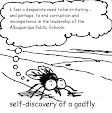 The Journal reports this morning, link, that NM Education Secretary Hanna Skandera will not prioritize reducing class size in allocating funding to public education. She believes there are better places to spend money. I'm inclined to agree. From a teachers perspective, reducing class size from 30 kids to 29 won't make all that much difference.
The Journal reports this morning, link, that NM Education Secretary Hanna Skandera will not prioritize reducing class size in allocating funding to public education. She believes there are better places to spend money. I'm inclined to agree. From a teachers perspective, reducing class size from 30 kids to 29 won't make all that much difference.
Skandera's research on class size is undoubtedly more recent and comprehensive than my own, but when I was still teaching, the research indicated that you had to get down to 15 to 1 before performance improved significantly.
In truth, the optimum ration of teacher to student is one to one. I heard someone argue once, that if you reflect on all the important things you have learned in your life, the overwhelming majority of them were learned in one on one conversations.
Cemetery seating; gathering 30 kids who have nothing in common but the year of their birth and a zip code, and then insisting that they form a thought choir and perform as a group through their entire education, is an obsolete model of education.
When there was only one teacher, or only one book, it might have been necessary to have every student focused on the same resource. It no longer is. The entire wealth of human knowledge is a key stroke away from anyone with internet access and the skill set they need to take advantage of it.
There is no good reason to group educate students. There is no justification for expending any more effort or resources trying to standardize individual performance. By definition, group learning eliminates the opportunity to teach to mastery. Mastery learning is the key to future learning. A student with a C in math is going to have more trouble with math next year, than a student with an A in math. Two students with the same command of math this year, will be equally successful next year.
There is no such thing as a "group" achievement gap. All achievement gaps are individual; one student, the skills s/he has already acquired compared to the skills s/he needs to acquire. You can if you want, take all Hispanic students and average all their individual achievement gaps. It is a meaningless statistic. Unless you you believe students are inherently disabled by their heritage, there is no group solution that applies to them because of their heritage. Group achievement gap statistics are useful only to those peddling group solutions to individual problems - publishers of textbooks and standardized tests.
Take any student, ask them a relatively few questions, and a plan can be created that will enable that student to leave school with the skill sets they need to live happily ever after. All we have to do is give every student the individual attention they need.
Individual attention cannot be given to students in groups. Teaching really can be likened to herding cats,especially young students. The point being; you cannot spend a lot of time on any one kitten without the rest wandering off. A teacher can spend some time with individual students if the rest of the can continue their education without the teacher's immediate attention.
Mother cats don't make their kittens march in formation. They allow inherent curiosity and enthusiasm to drive the quest for knowledge. They create independent lifelong learners as quickly as they can.
Cemetery seating suits the needs of a handful of average students. More able students are held back, less able students are left behind. They will not catch up. They will continue to fall further and further behind until they drop out.
Education reform in Roundhouse seems to be limited to beating a dead horse; group solutions for individual problems. The model cannot be made to work. If ever it was the best or only solution, it is no longer.
Reform needs to include a reassessment of the most basic assumptions about education.
photo Mark Bralley
Saturday, January 25, 2014
Ideal pupil teacher ratio 1 to 1, and it is entirely doable.
Posted by
ched macquigg
at
7:55 AM
![]()
Subscribe to:
Post Comments (Atom)

2 comments:
http://education.jhu.edu/PD/newhorizons/Transforming%20Education/Articles/Class%20Size/
A link about class size from John Hopkins.
Thank you for the link. It is a good read.
Post a Comment